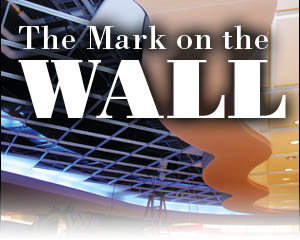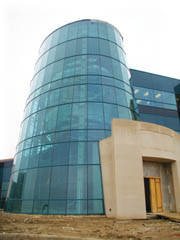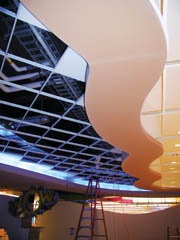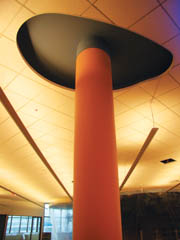

When completed, the Southfield Public Library will be a 125,000-square-foot facility to house its abundance of community resources. Anything from Agatha Christie novels for the kids on the main level, to Graham Greene for the fiction consumers on the second floor, to books on Pol Pot for the historians on the third floor’s non-fiction department, can be found among layers of the metal-framed, drywalled, acoustical- and wood-paneled, and plastered coliseum.

Blast off
Since community support was strong for the newer and stronger facility, the project was approved and the bid work contracted out in 1999, with the construction dates beginning in 2002. In addition to the three floors (first is for children; second fiction and audio-visual; third non-fiction), the unit also contains an auditorium, computer training labs, collaborative learning rooms and for java lovers, a caf?Collectively, the state-of-the-art learning center should be in full operation by summer. The total cost for the project is estimated at $36.8 million.The architect is Phillips Swager Association, Dallas, a firm selected for its attention to new and renovated jobs done to libraries throughout the states. Working closely with PSA is George W. Auch, a general contracting company out of Southfield’s’ neighboring Pontiac, Mich., whose resume includes such awards as the 2002 winner of “Metropolitan Detroit’s 101 Best and Brightest Companies to Work For,” as well as ranking number eight in Crain’s “2001 List of Contractors” for Metro Detroit.
For the most part, the city of Southfield was receptive to approve the grand-scale building with a full understanding of what it would cost taxpayers. But for those who frequent the cluttered layout of the current facility, the new library will be a chance to read and visit in a more spacious, better-lit environment with comfort and ease of entrance/exit access.
“Primarily, reading today is essential to a person’s survival in society,” says Doug Zyskowski, city librarian of Southfield Public Library. “A lot of things compete for children’s and adults’ time—television, video games and so on. In order for the library to encourage attendance, we need to provide a very stunning building and we think we’ve done that.”
There will be plenty of visual stimulation for both children and adults. In particular, the first floor (the “kids’ room”) is a landscape of fantasy and nature: a castle made of books, a tree house made of faux oak, a dragon’s lair and a reading area that resembles a space ship are all part of the package. In this “space” room, drywall was hung in stacks, with little holes cut throughout the board. When viewed in the dark, bulbs flicker to create a twinkling sky.
“In the youth room, our goal was to create an environment that kids would find enticing,” says Zyskowski. “We wanted to have a place that would encourage kids’ imagination and give them a reason to visit the library.”

The yoke of the egg
If theme construction such as castles and space frontier cater to youth, likeminded amenities for the adults was another goal. To attain this, architectural designs such as curves, dangling soffits and floating objects should be complementary ideas that will invite all age brackets to enjoy the experience together. Suspended above the main-entrance lobby is an elliptical-shaped room of both the horizontal and vertical plane. As its frame, prefabricated 16-gauge 35⁄8-inch C-studs of metal framing from Clark Western Lath & Steel Framing Systems were carefully shaped using a stud bender.“To lay that out, I had to section it out on the floor to get an idea of how to build it,” says Neal Bowlus, superintendent with drywall contractor Turner-Brooks, of Madison Heights, Mich. “I had to pick a plane, in that sphere, that intersected the floor level. I had to work the ellipse and the radius to allow me to get the proper layout of the angle. The exterior part of that room has openings that intersect at the different radii and we worked to maintain equal spacing in between.
“The interior walls are plumb, the exterior walls’ radius—but they were on an ellipse so they increase or decrease depending on which direction we were going from center,” says Bowlus. “I figured what that radius was going to be mathematically and I ordered the studs. They were more than 28 feet long. We built units where we combined two of those studs, open-side together, so we’d create more or less a tube stud and strapped them together so we had a section in between. That was the only way we got something to relate to and tie to and build everything to. We did these set by set. Once we had the metal framing done, we laid the High Flex 1/4-inch and pieced that on there.”
In order to wrap the board across the curved metal framing, Turner-Brooks would try to lay as much of the 4-feet-by-8-feet sheets in whole as possible.
“We worked it around as much as possible and relief cut it to let it come in, to break it at the stud,” Bowlus continues. “We used two layers of the National Gypsum board. That was the only way of covering everything.”
With drywall hung horizontally, the mudding and taping gave the workers “more latitude.” Occasionally, when laying the sheets, the board would “run off” with cracks, and the process would have to start over.
Supporting the oval-shaped room are two structural beams. As of press time, the beams were exposed and only bore sprayed-on fire stopping. At 60-feet tall, the beams are on an 8-degree angle to be covered with prefabricated columns manufactured by Fry Reglet.
Other challenges of the project utilized hundreds—if not thousands—of curved metal framing for an elaborate layout of soffits on the first floor, and sprinkled throughout elsewhere. Overlapping serpentine soffits come down in short lengths (some at only 3 inches) on top of other tracks of soffits. The layout of these serpentine patterns was laid out on the floor, directly below where the tracks were to be installed. Some of these bendable tracks were installed in areas that were much more elevated than the standard ceiling height.
“There wasn’t a straight wall or drop in the project—everything was different,” says Mike Harry, project director of Turner-Brooks. “The deck height is 18 feet, and as you get above 14 feet, things slow down considerably.”
For not only safety but the practicality of installation, an intricate scaffolding unit had to be layered in the area of the spiral staircase, a unit that stretches from the first to third floors. For more intricate ceiling and soffit work, planks were stretched and intersected from the top of the stair opening, then sheeted in with plywood, with yet another scaffold tower erected on top to make possible the installation of more drywall. The control joints installed in this board with a zigzag pattern.
“We were fortunate that in our time frame we were able to manage that project with very skilled people,” concludes Harry.
Slated for a July 2003 public opening, the project will appear to be a fresh and exciting start for those that it services. Ten years ago, the library had offered approximately 500,000 items in circulation and had just introduced the first ever public remote access to its catalog, justifying future growth. With this new facility that more than doubles its current features and services, it may not be Disney World, but it rivals the didactic nature of the Epcot in architecture, construction and education.


Report Abusive Comment